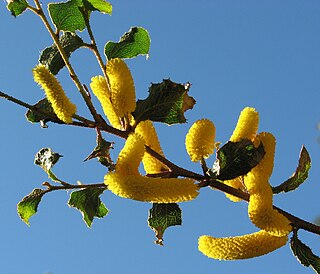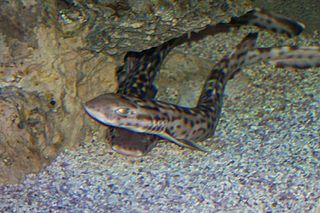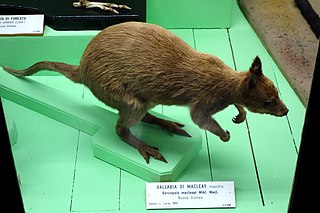
Chondrichthyes is a class that contains the cartilaginous fishes that have skeletons primarily composed of cartilage. They can be contrasted with the Osteichthyes or bony fishes, which have skeletons primarily composed of bone tissue. Chondrichthyes are jawed vertebrates with paired fins, paired nares, scales, and a heart with its chambers in series. Extant chondrichthyes range in size from the 10 cm finless sleeper ray to the 10 m whale shark.

Catsharks are ground sharks of the family Scyliorhinidae. They are one of the largest families of sharks with around 160 species placed in 17 genera. Although they are generally known as catsharks, many species are commonly called dogfish or gato. Like most bottom feeders, they feed on benthic invertebrates and smaller fish. Catsharks are not harmful to humans.

The ocean sunfish or common mola is one of the two heaviest known bony fishes in the world, the other being the southern sunfish of the same genus. Adults typically weigh between 247 and 1,000 kg (545–2,205 lb). The species is native to tropical and temperate waters around the world. It resembles a fish head with a tail, and its main body is flattened laterally. Sunfish can be as tall as they are long when their dorsal and ventral fins are extended.

Sandpaper and glasspaper are names used for a type of coated abrasive that consists of sheets of paper or cloth with abrasive material glued to one face.

Sawfish, also known as carpenter sharks, are a family of rays characterized by a long, narrow, flattened rostrum, or nose extension, lined with sharp transverse teeth, arranged in a way that resembles a saw. They are among the largest fish with some species reaching lengths of about 7–7.6 m (23–25 ft). They are found worldwide in tropical and subtropical regions in coastal marine and brackish estuarine waters, as well as freshwater rivers and lakes. They are also endangered.

Paratrachichthys trailli, the sandpaper fish, is a slimehead belonging to the family Trachichthyidae, found in southern Australia and southern New Zealand at depths between 20 to 500 metres. It can reach lengths of up to 25 centimetres (9.8 in).

Acacia denticulosa, commonly known as sandpaper wattle, is a species of Acacia native to the south-west of Western Australia. A spindly shrub 1–4 m high, it flowers from September to October, producing dense, curved, yellow flower spikes.

Atelomycterus is a genus of catsharks in the family Scyliorhinidae.

The Australian marbled catshark is a catshark of the family Scyliorhinidae, found in the eastern Indian Ocean, endemic to Western Australia between latitudes 12 and 21°S, from the surface to 245 m (800 ft) deep. Its length is up to 60 cm (24 in), and it typically inhabits coastal waters with sandy or rocky bottoms.
Australian Aboriginal fibrecraft refers to the various ways Aboriginal Australians create fibres traditionally. Materials used depend on where the people live in Australia.

The forest kingfisher, also known as the Macleay's or blue kingfisher, is a species of kingfisher in the subfamily Halcyoninae, also known as tree kingfishers. It is a predominantly blue and white bird. It is found in Indonesia, New Guinea and coastal eastern and Northern Australia. Like many other kingfishers, it hunts invertebrates, small frogs, and lizards.

Macleay's dorcopsis, also known as the Papuan dorcopsis or the Papuan forest wallaby, is a species of marsupial in the family Macropodidae. It is endemic to Papua New Guinea, where its natural habitat is subtropical or tropical dry forests. Being little threatened by habitat destruction, the International Union for Conservation of Nature has rated it as being of "least concern".
Bentosites macleayi is a species of air-breathing land snails, terrestrial pulmonate gastropod mollusks in the family Camaenidae.

Ficus coronata, commonly known as the sandpaper fig or creek sandpaper fig, is a species of fig tree, native to Australia. It is found along the east coast from Mackay in Central Queensland, through New South Wales and just into Victoria near Mallacoota. It grows along river banks and gullies in rainforest and open forest. Its common name is derived from its rough sandpapery leaves, which it shares with the other sandpaper figs.

Ficus fraseri, the white sandpaper fig or shiny sandpaper fig, is one of several fig species commonly known as sandpaper figs. It is native to New South Wales, Queensland and the Northern Territory in Australia and to New Caledonia and Vanuatu. Other common names are "figwood" and "watery fig".

Paratrachichthys is a genus of slimeheads found in the Pacific Ocean. It consists of three species, all known as sandpaper fish.

Zaniolepis latipinnis, the longspine combfish or longspined greenling, is a species of greenling. This species has rough, sandpaper-like skin, and lives in cold marine waters. It inhabits the muddy bottoms of shallow coastal waters, between 35 and 250 m depth. It is endemic to the northeast Pacific Ocean.

Ambassis macleayi, commonly known as Macleay's glassfish, Macleay's glass perchlet, Macleay's perchlet, reticulated glassfish, reticulated perchlet, or network perchlet, is a species of freshwater fish in the family Ambassidae. It is native to northern Australia and the trans-Fly River region of New Guinea. It is a fish with a vertically flat, narrow body and a standard length generally between 35 and 45 mm, with large specimens reaching 77 mm (3.0 in) long. It generally eats water fleas and other small invertebrates. This fish is considered to be a least-concern species according to the International Union for Conservation of Nature (IUCN), although it could suffer from habitat degradation due to feral pigs and invasive water plants such as the water hyacinth. The fish is suitable for aquarium use in tanks containing other non-aggressive species.
Aulotrachichthys heptalepis, also known as the Hawaiian luminous roughy, is a slimehead found in the Hawaiian Islands south of Niihau, the westernmost island. It has a depth range of 50 to 100 metres. Males can reach a maximum length of 6.7 centimetres (2.6 in) TL while females can reach 5.1 centimetres (2.0 in) SL. It was first described in 1984 after 33 individuals were caught by the U.S. National Marine Fisheries Service in a series of cruises of the Hawaiian Islands.

Flying Fish Point is a coastal town, locality and headland in the Cassowary Coast Region, Queensland, Australia. In the 2016 census, Flying Fish Point had a population of 425 people.















